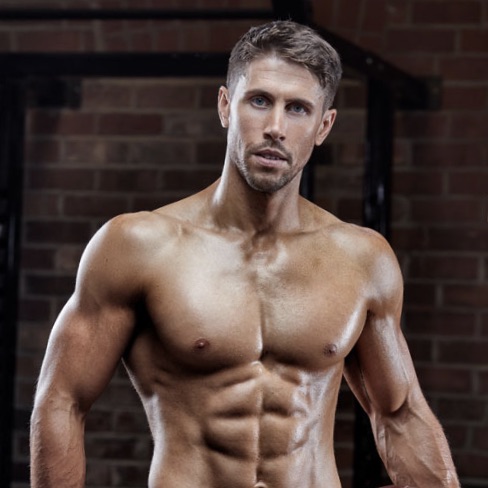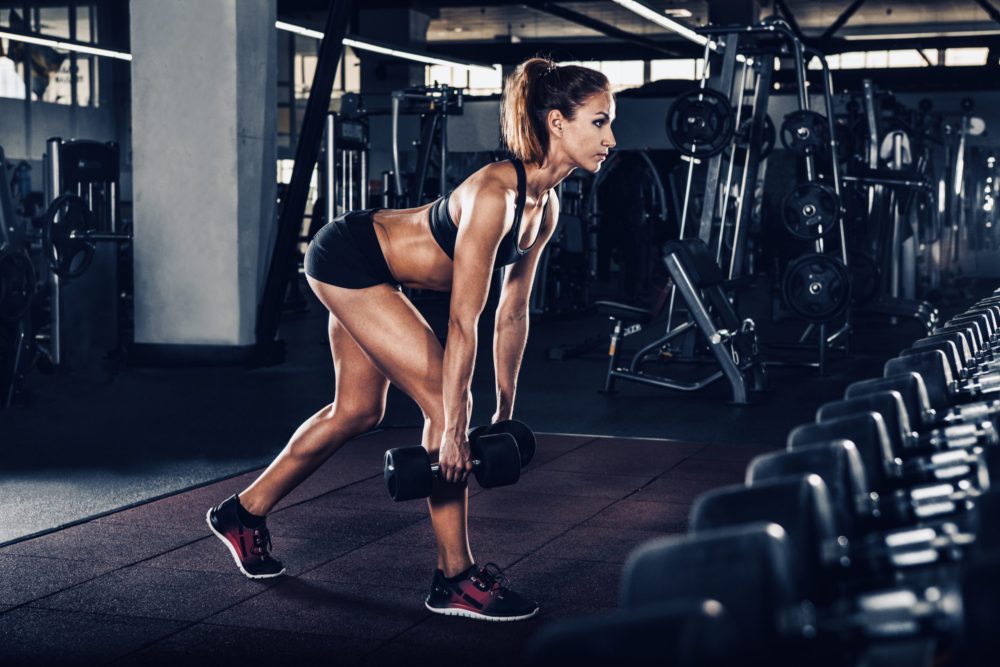Many neglect single-leg exercises in place of “beefier” lifts. This is a mistake, and especially when it comes to your glutes and hamstrings leaves some benefits untapped.
Single-leg exercises build unilateral strength and stability which can improve functional performance and toughness against injury – “Functional” meaning a better carryover to anything that requires you stabilize and exert force one leg at a time (sprinting, running, walking?!).
You can achieve similar levels of muscle activation and energy expenditure using single-leg exercises as you might do during a double-leg counterpart. For example single-leg squats achieve similar muscle activity in the hamstring, calf, hip and abdominal muscles and create less load on the spine versus back squats (1).
Taking some time to develop your single-leg strength will not only help you build a better backside while remaining injury free, but they’ll benefit your double-leg lifts too. Here’s how to crush your glutes and hamstrings using single-leg training.
Use a shorter bar for more stability on single-leg hip thrusts
Most can agree that hip-thrusts are the king of butt builders. The setup allows you to maximally load your glutes in their fully shortened position, while the placement of the bar loads your hips in a more horizontal direction. This is great for a perky posterior as well as your athleticism and sports speed.
Hip-thrusts and bridges are also relatively versatile. They can be adapted to emphasize your glutes even further, or shift more tension on to your hamstrings. For example having your back on the floor while placing your foot on a box will further target your hamstrings. This position can be truly horrible in all the right ways if you get it right.
Performing hip-thrusts on one-leg are much less common than their heavier two-legged equal. Many find them too unstable and are disappointed they’re not thrusting the weights they’re used to. By using more single-leg hip-thrusts you’ll help correct that – You’ll develop better hip stability and strength and be able to hip-thrust more on one leg over time.
Instead of using a long bar, a shorter bar can be more comfortable and stable. A 4ft stubby bar works great, or some EZ bars will fit comfortably over your hips too. Check out the Maverick Glutes and Hamstrings Guide HERE for some advanced hip thrust progressions.
The best single-leg squats for glutes and hamstrings
Skater Squats build single-leg strength and stability. Structurally they suit many better than trying to perform single-leg squats using the “pistol” technique. They’re also a more hip-dominant variation with a greater forward torso lean.
Try skater squats with bodyweight alone to really dial in the position. You’ll also want to start with an airex pad or small step for your back knee. This works as a depth gauge and reduces range of motion until you can achieve full depth. Over time you should get your knee closer to the floor, and without having to bounce off it.
Hold a couple of light dumbbells in front. This isn’t a way to lose the exercise, but will act as a slight counterbalance. Even a few pink dumbbells should suffice. As you get better throw on a weighted vest. You can also do skater squats off a platform for extra depth.
Master your single-leg deadlifts
Romanian and single-leg Romanian deadlifts (RDL’s) are the best medicine for a single weak hamstring. They’re also a pretty good glutes builder. There are some corrections you need to make though, if you want to get the most from them.
First, lack of balance can stop you lifting the weight your glutes and hamstrings are capable of. And second, you need to be working your glutes and hamstrings and not your lower back. Deadstop RDL’s are just one way to help control both.
Adding a deadstop gives you a chance to reset and gain balance. As you stop on the floor or step you regain some composure. The idea is to not lose the weight fully though. Maintain tension by only letting about 50% of the weight get lost through the floor or step.
The deadstop inhibits some muscle elastic properties too, making lighter weights feel heavier and really emphasizing the contraction of your hamstrings at full length. Adjust the height of the step to allow this to happen while keeping your depth consistent. You want to see a full hinge of your hips while maintaining a stable lumbar region. Dumbbell, kettlebell or even deadstop landmine deadlifts work great.
Pick single-leg exercises that activate your glutes while minimizing hip flexor recruitment
Not so much when training your hamstrings, but when trying to target your glutes it’s common for your hip flexors to want to get involved. This is especially true during exercises that look like a half-assed kick out towards the side – And don’t tell me you don’t know someone that does these. If you want meaty hip flexors and contribute towards an imbalance associated with back pain then go for it. Otherwise consider exercises where the ratio of glute to hip flexor activation is favorable.
Side-lying clams when correctly performed can activate your glutes to a respectable level, especially upper glute fibers and glute medius. They also involve little activation of your hip flexors so are a good choice of isolation exercise. Side-lying abductions can also be good. With these you want to attempt to lead with your heel turned outward to maximize their benefits. A more advanced option is the “Running Man”.
The “Running Man” challenges your glute strength in multiple planes, as well as your single-leg stability and coordination. Also, it burns like a mofo (even without resistance)! In a study, data showed the Running Man outperformed 12 other common glutes exercises in its ability to produce high levels of activation in both glute max and glute med (2).
You can perform the Running Man with or without the back foot touching the floor, although you do want to limit yourself from actively pushing off with it. For a more intense variation you can also give this version a go, which almost resembles a reverse lunge. These’ll work wonders for your hamstrings too.
Choose reverse lunges instead of forward reverse lunges
Reverse lunges tend to be better than forward lunges for glute and hamstring development. That’s not to say forward lunges don’t do anything, but stepping backwards instead of forwards tends to offer more to your cause.
Walking lunges can offer quite a bit too, with a few alterations. By tilting forward slightly and reducing the amount of knee bend in the forward leg you can make a more hip-dominant walking lunge.
Reverse lunges will build incredible single-leg strength, stability and better glutes and hamstrings. But incorporating sliders can also have some additional benefits.
Sliders force your forward lunge leg to work harder. This is because they eliminate the “push” from the back leg that’s often used to cheat in reverse lunges. This push from the back foot is also a hidden culprit for knee pain.
A common error in regular reverse lunges is the lack of eccentric control. Sliders help make the most of the eccentric, which is great for both building muscle and injury prevention. You’re also forced to contend with the friction on the floor as an extra challenge to your hamstrings in particular. Regular reverse lunges and hip-dominant walking lunges are great, but for some other benefits try incorporating sliders.
Adapt your split squats to hit your glutes and hamstrings harder
If you don’t have a list of split squat progressions and variations in your training toolbox then you’re missing out. They’re a key exercise for building badass single-leg strength and stability. To make them more hip-dominant though, you’ll want to try a few things.
Standing on a step or two will create a deficit, requiring your hips to go through a greater range of motion. For your glutes in particular this extra range of motion loads them in a further stretched position leading to more mechanical tension and muscle tissue breakdown. Both good things for muscle growth. Performing isometric holds in this deficit position is another, and very powerful method. We’ll get deeper in to this another time (pun intended).
Adding a forward lean in split squats, like you might in lunges, is another way to increase glutes and hamstrings engagement. This method is particularly useful for loading your glutes in their more stretched (lengthened) position, while also helping recruit your hamstrings further. Cable reaching split squats are something I’ve spoken of many times before and for good reason. You’ll find them in the Maverick Glutes and Hamstrings guide along with many other split squat variations to add to your toolbox HERE.
Try using a kick stance for your deadlifts
Single-leg deadlifts should be a key component within you glutes and hamstrings-focused training plans. They can take pride of place in any program. Or, they can take more of a back seat as an assistance exercise and even part of your warm-ups. The trouble is many don’t have the balance to go heavy enough to get the most from them. Even Deadstop RDL’s as previously mentioned can feel like a circus balancing act for some.
The simplest option with single-leg deadlifts is to place your free hand on a wall or bench for support. And these work a treat. There is another option though and one that’s pretty popular at the minute. The Kickstance RDL is somewhere between a single-leg RDL and your usual two-legged RDL’s. They’re a single-leg deadlift with some support from your back foot.
Now, here’s the key to doing them correctly: There should only be some support coming from your back foot. That is, the “Kickstance” foot is not there to help you lift more. Doing this is the equivalent to performing a step-up while bouncing your trailing foot off the floor. Not cool. Your back foot is simply there for an extra point of contact and to help a little with balance.
Consider the Kickstance like a partially supported single-leg deadlift. Focus on placing the most weight through your front leg, while the back should do very little. This requires some awareness. If you can’t do this then using a split squat stand or foam roller for your back foot can help stop the cheating. Do these right and you’ll be sorely reminded about them for days!
Roundup
You can place as much emphasis on single-leg exercises as you like within your training. But skip them completely and you’re skipping out on some progress. As a tool to develop your glutes and hamstrings these tips will give you a good place to start.
Bust through plateaus and take your physique to the next level with The Fitness Maverick Online Coaching Program!
- Eliassen et al. “COMPARISON OF BILATERAL AND UNILATERAL SQUAT EXERCISES ON BARBELL KINEMATICS AND MUSCLE ACTIVATION.” International journal of sports physical therapy vol. 13,5 (2018): 871-881.
- Bishop et al. Electromyographic Analysis of Gluteus Maximus, Gluteus Medius, and Tensor Fascia Latae During Therapeutic Exercises With and Without Elastic Resistance. Int J Sports Phys Ther vol. 13, 4 (2018): 668-675.

I build Olympians, Cover Models and those who want to look like them. Author or “Ultimate Abs” available in all good book stores.
